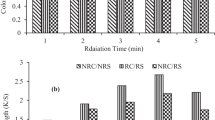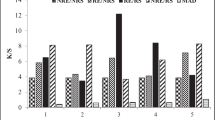Abstract
Application of natural colorants to textile fabrics has gained worldwide public acceptance due to the hazardous nature of synthetic dyes. Present study investigated the microwave’s mediated extraction of natural colorants from leaves of milkweed (Calotropis procera L.) as well as their application to cotton fabrics assisted with biochemical mordants. Dye extraction from C. procera leaves was carried out in various mediums (alkali and aqueous), and the extracted dye as well as cotton fabrics was irradiated with microwaves for 2, 4, 6, 8, or 10 min. Effect of various temperature regimes and sodium chloride (NaCl) concentrations was also evaluated on the color strength of dyed cotton fabrics. The results revealed that extraction of natural colorants was enhanced when microwave radiations were applied for 4 min by using alkali as an extraction medium as compared to aqueous one. Optimum dyeing of cotton fabrics was achieved by using NaCl at a temperature of 55 °C. Among the chemical mordants, iron was effective for better color strength when used as pre- and post-mordant. Among the studied bio-mordants, extract of Acacia nilotica bark significantly improved the color strength and fastness properties as pre-mordant and Curcuma longa tuber as post-mordant. It was concluded that extract of C. procera leaves was a potential source of natural colorants and a high level of dye was obtained upon irradiation of alkali-solubilized extract for 4 min. Application of NaCl at concentration of 3 g/100 mL and temperature treatment of 55 °C significantly improved the color strength of dyed cotton fabrics.


Similar content being viewed by others
References
Abdel-Thalouth I, Ragheb AA, Rekaby M, El-Hennawi HM, Shahin AA, Haggag K (2014) Application of microwave in textile printing of cellulosic fabrics. Res J Chem Sci 4(9):41–46
Adeel S, Rehman FU, Hanif R, Zuber M, Haq EU, Muneer M (2014) Ecofriendly dyeing of UV-irradiated cotton using extracts of Acacia nilotica bark (Kikar) as source of quercetin. Asian J Chem 26(3):830–834
Adeel S, Usman M, Haider W, Saeed M, Muneer M, Ali M (2015) Dyeing of gamma irradiated cotton using Direct Yellow 12 and Direct Yellow 27: improvement in colour strength and fastness properties. Cellulose 22(3):2095–2105
Ado A, Yahaya H, Kwalli AA, Abdulkadir RS (2014) Dyeing of textiles with eco-friendly natural dyes: a review. Int J Environ Monit Assess 1(5):76–81
Ajmal M, Adeel S, Azeem M, Zuber M, Akhtar N, Iqbal N (2014) Modulation of pomegranate peel colourant characteristics for textile dyeing using high energy radiations. Ind Crop Prod 58:188–193
Al-Snafi AE (2015) The constituents and pharmacological properties of Calotropis procera—an overview. Int J Pharm Sci Rev Res 5(3):259–275
Batool F, Adeel S, Azeem M, Khan AA, Bhatti IA, Ghaffar A, Iqbal N (2013) Gamma radiations induced improvement in dyeing properties and colorfastness of cotton fabrics dyed with chicken gizzard leaves extracts. Rad Phy Chem 89:33–37
El-Khatib EM, Ali NF, Ramadan MA (2014) Environmentally friendly dyeing of silk fabrics using microwave heating. Int J Curr Microbiol Appl Sci 3:757–764
Gao F, Ding H, Xu X, Zhao Y (2016) A self-sufficient system for removal of synthetic dye by coupling of spore-displayed triphenylmethane reductase and glucose 1-dehydrogenase. Environ Sci Pollut Res. doi:10.1007/s11356-016-7330-9
Gulzar T, Adeel S, Hanif I, Rehman F, Hanif R, Zuber M, Akhtar N (2015) Eco-friendly dyeing of gamma ray induced cotton using natural quercetin extracted from acacia bark (A. nilotica). J Nat Fibers 12(5):494–504
Haji A, Qavamnia SS (2015) Response surface methodology optimized dyeing of wool with cumin seeds extract improved with plasma treatment. Fiber Polym 16(1):46–53
Hasan MM, Hossain MB, Anwarul Azim AYM, Ghosh NC, Reza MS (2014) Application of purified curcumin as natural dye on cotton and polyester. Int J Eng Technol 14(5):17–23
Hassan LM, Galal TM, Farahat EA, El-Midany MM (2015) The biology of Calotropis procera (Aiton). Trees 29:311–320
Iqbal J, Bhatti IA, Adeel S (2008) Effect of UV radiation on dyeing of cotton fabric with extracts of henna leaves. Indian J Fibre Text Res 33:157–162
Jihad R (2014) Dyeing of silk using natural dyes extracted from local plants. Int J Sci Eng Res 5(11):809–818
Khan AA, Iqbal N, Adeel S, Azeem M, Batool F (2014) Extraction of natural dye from red calico leaves: gamma ray assisted improvement in colour strength and fastness properties. Dyes Pigment 103:50–54
Leitner P, Fitz-Binder C, Mahmud-Ali A, Bechtold T (2012) Production of a concentrated natural dye from Canadian goldenrod (Solidago canadensis) extracts. Dyes Pigments 93(1):1416–1421
Marie MM, Shokry GM, El-Khatib SMF (2015) One bath cationization and dyeing of cotton fabric with Brazilwood natural dye. Int J Innov Appl Stud 11:928–941
Mongkholrattanasit R, Krystufek J, Wiener J, Studnickova J (2011) Natural dye from eucalyptus leaves and application for wool fabric dyeing by using padding techniques. In: Kumbasar EA (ed) Natural dyes. Zagreb intech publisher, Zagreb, pp. 57–78
Muneer M, Bhatti IA, Adeel S (2010) Removal of Zn, Pb and Cr in textile waste water using rice husk as a biosorbent. Asian J Chem 22:7453–7459
Oyelude EO, Owusu UR (2011) Adsorption of methylene blue from aqueous solution using acid modified Calotropis procera leaf powder. J Appl Sci Environ Sanit 6(4):477–484
Sinha K, Saha PD, Datta S (2012) Response surface optimization and artificial neural network modeling of microwave assisted natural dye extraction from pomegranate rind. Ind Crop Prod 37(1):408–414
Sivakumar V, Vijaeeswarri J, Anna JL (2011) Effective natural dye extraction from different plant materials using ultrasound. Ind Crop Prod 33:116–122
Wang Y, Lee C, Tang Y, Kan C (2016) Dyeing cotton in alkane solvent using polyethyleneglycol-based reverse micelle as reactive dye carrier. Cellulose 23:965–980
Zhang X, Wu C, Wu H, Sheng L, Su Y, Zhang X, Luan H, Sun G, Sun X, Tian Y, Ji Y, Guo P, Xu X (2013) Anti-hyperlipidemic effects and potential mechanisms of action of the caffeoylquinic acid-rich Pandanus tectorius fruit extract in hamsters fed a high fat-diet. PLoS One 8:1–12
Acknowledgements
Our research work was financed by the Government College University, Faisalabad, Punjab, Pakistan, under annual research fund for the Department of Botany. We gratefully acknowledge the Noor Fatima Textile (Pvt) Faisalabad, Pakistan, for the evaluation of color strength and the rating of colorfastness. We also thank Dr. M. Sohail Akram for reading the MS for the English language.
Author information
Authors and Affiliations
Corresponding author
Additional information
Responsible editor: Philippe Garrigues
Electronic supplementary material
Fig. S1
Impact of microwave radiations on the color strength of dyed cotton fabrics samples with aqueous extract (a) and alkali extract (b) of milkweed leaves (RS/RC: Irradiated solution/ irradiated cotton, RS/ NRC: Irradiated solution/ un-irradiated cotton, NRS/NRC: Un-irradiated solution/ un-irradiated cotton). (DOCX 20 kb)
Fig. S2
Impact of various dyeing temperatures on the color strength of un-irradiated cotton using treated alkali extract of milkweed leaves. Significant differences for temperature treatments were represented by different letters (a-d). n = 4, Mean ± SE. (DOCX 16 kb)
Rights and permissions
About this article
Cite this article
Hussaan, M., Iqbal, N., Adeel, S. et al. Microwave-assisted enhancement of milkweed (Calotropis procera L.) leaves as an eco-friendly source of natural colorants for textile. Environ Sci Pollut Res 24, 5089–5094 (2017). https://doi.org/10.1007/s11356-016-8162-3
Received:
Accepted:
Published:
Issue Date:
DOI: https://doi.org/10.1007/s11356-016-8162-3




